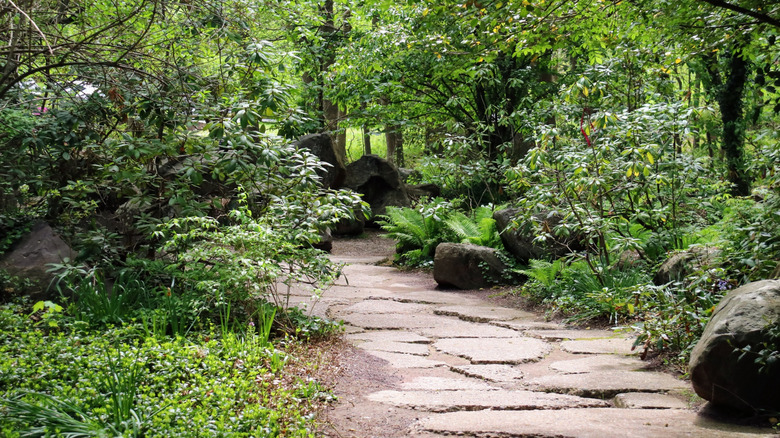The Shade-Loving Perennial That Will Be Perfectly At Home In Your Woodland Garden
Cultivating a woodland garden can be both magical and practical. If you have space in your yard with plenty of shade trees or even dense cover, you have the ideal environment for shade-loving plants. There's a particular perennial wildflower that's right at home in a fantasy-inspired woodland garden: little sweet Betsy (Trillium cuneatum), also known as the bloody butcher, large toadshade, and whippoorwill flower. Whatever you choose to call it, this flowering plant with silver foliage will give your garden a fantasy vibe thanks to its love of darkness, attractiveness to wildlife, ability to suppress weeds, and unique appearance.
In the spring, from April to May, you will be greeted by maroon or bronze-colored flowers poking out from mottled green-gray leaves. This native flowering groundcover grows wild in mountainous areas in the Southeast U.S., including parts of Kentucky, North Carolina, and Illinois. Little sweet Betsy is hardy in Zones 5 to 8 and needs moist but well-draining soil to thrive. The native black-patched clepsis moth and the American angle shades moth lay their eggs on the plant, and the flowers attract ants. In the summer, small mammals forage the plant's berries. Not sure how to turn your garden into a certified wildlife habitat? Planting little sweet Betsy in your woodland garden is a good start.
How to add little sweet Betsy to your woodland garden
Ideally, plant your little sweet Betsy in a spot that gets little to no sun — the plant prefers part or deep shade. This sweet little native grows well in mass plantings, but you need to site the patch under tree cover if you want it to grow full and bountiful. It spreads fairly effectively via rhizomes, though rather slowly. You don't need to worry about it overtaking other plants.
The maroon, yellow, orange, or red-green flowers of little sweet Betsy have a passing resemblance to lilies. The blooms are an unexpected reason why this plant is perfect for that wild woodland garden at the very back of your yard. They boast a faint, banana-like smell that attracts flies. Some people find the scent unpleasant, so choose where you plant it accordingly. Although this ephemeral flower's foliage dies back by mid-summer, it will return in the spring to add a flash of color — in the form of leaves, flowers, and berry-like capsules — to your shady woodland garden beds.
If you are seeking a shade-loving plant combo that makes woodland borders glow, consider pairing little sweet Betsy with false Solomon's seal (Maianthemum racemosum). You'll be bringing together two native wildflowers that love the shade and rich, moist soils, and the preferred USDA Hardiness Zone for false Solomon's seal, Zones 3 to 9, encompasses that of little sweet Betsy. You can even grow both successfully from seed, which is helpful because little sweet Betsy isn't a good candidate for transplanting.

